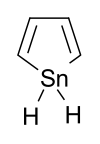Stannole
Appearance
| |||
| Names | |||
|---|---|---|---|
| IUPAC name
1H-Stannole
| |||
| Identifiers | |||
3D model (JSmol)
|
|||
CompTox Dashboard (EPA)
|
|||
| |||
| |||
| Properties | |||
| C4H6Sn | |||
| Molar mass | 172.802 g·mol−1 | ||
Except where otherwise noted, data are given for materials in their standard state (at 25 °C [77 °F], 100 kPa).
| |||
Stannole is an organotin compound with the formula (CH)4SnH2. It is classified as a metallole, i.e. an unsaturated five-membered ring containing a heteroatom. It is a structural analog of pyrrole, with tin replacing the nitrogen. Substituted derivatives, which have been synthesized, are also called stannoles.[1]
Examples
1,1-Dibutylstannole is a pale yellow oil prepared from 1,4-dilithio-1,3-butadiene and dibutyltin dichloride [2]
Reactions
1,1-Dimethyl-2,3,4,5-tetraphenyl-1H-stannole, for example, can be formed by the reaction of 1,4-dilithio-1,2,3,4-tetraphenyl-1,3-butadiene and dimethyltin dichloride.[3] 1,1-Disubstituted stannoles can be formed in the [2+2+1] cycloaddition reaction of two acetylene molecules with an organotin molecule SnR2.[4]
See also
References
- ^ Dubac, Jacques; Laporterie, Andre; Manuel, Georges (1990). "Group 14 metalloles. 1. Synthesis, organic chemistry, and physicochemical data". Chemical Reviews. 90: 215. doi:10.1021/cr00099a008.
- ^ Ashe, Arthur J.; Mahmoud, Samir. (1988). "1,4-Dilithio-1,3-butadienes". Organometallics. 7 (8): 1878. doi:10.1021/om00098a034.
- ^
J.I.G. Cadogan, S.V. Ley, G. Pattenden, R.A. Raphael, C.W. Rees, ed. (1996). Dictionary of Organic Compounds. Vol. 3 (6 ed.). Chapman & Hall. p. 4219. ISBN 978-0-412-54090-5. Retrieved 2010-03-04.
{{cite book}}: CS1 maint: multiple names: editors list (link) - ^ Davies, A.G. (2004). Organotin Chemistry (2 ed.). Wiley-VCH. p. 129. ISBN 978-3-527-31023-4. Retrieved 2010-03-04.



